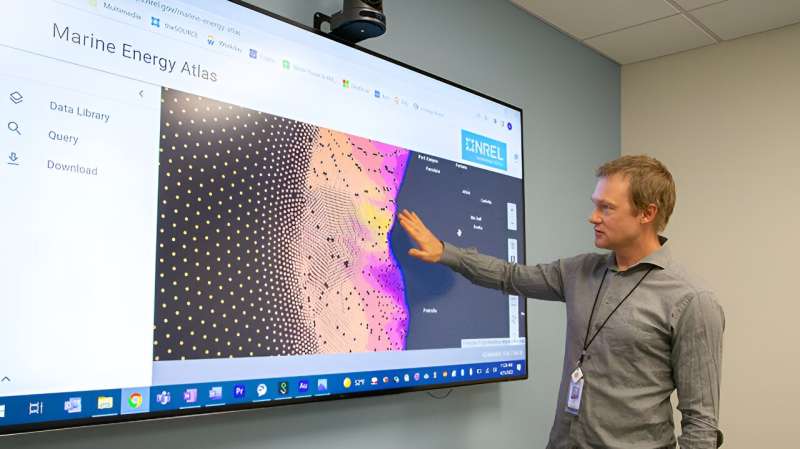This article has been reviewed according to Science X's editorial process and policies. Editors have highlighted the following attributes while ensuring the content's credibility:
fact-checked
peer-reviewed publication
trusted source
proofread
New study could help countries better estimate how much wave energy is in their oceans

The ocean, like a teething toddler, is never still. And both creatures contain shocking amounts of energy. But exactly how much energy surges through our ocean waves is a matter of debate. That uncertainty makes it challenging for countries to weave wave energy into their future climate goals: How can you rely on something you cannot accurately measure?
Now, in a study published in Renewable Energy, researchers from the National Renewable Energy Laboratory (NREL) and Pacific Northwest National Laboratory present a more comprehensive and accurate methodology to measure the wave energy available in ocean sites around the world. But they also identified another challenge: Existing wave energy data sets, the ones the team used to build their new methodology, may not be as reliable as previously thought.
Wave energy is not only predictable—making it a valuable complement to variable renewable energy sources—it is also available along coastlines where the majority of the world's population lives. But wave energy could do more than power coastal communities; this renewable could create clean drinking water from the ocean, power offshore seafood farms, and help decarbonize international shipping—all with energy from the ocean itself.
But to plan for all those applications—each of which will require investments from companies, industries, or entire countries—we need reliable data.
"Wave energy technology is at such an early stage," said Levi Kilcher, a senior researcher at NREL and the lead author of the study. "Because the industry is still young, it's challenging to estimate how much energy future technologies might capture."
For this study the team built a new method to estimate total wave energy potential. "The original wave resource assessment was a great first start. But there were also several critiques of that method," Kilcher said.
For example, previous methodologies did not account for wave direction—which direction a wave rolls in from. "That can actually lead to double-counting waves," Kilcher said.
Some waves are born far offshore, frothed up by a storm perhaps, and travel thousands of miles before crashing on a country's shoreline. "But there's quite a bit of wave energy that's generated by winds blowing inside a country's maritime boundaries," Kilcher said. His new method accounts for wave direction and those local waves, too.
"The other neat thing is that our method works for all scales—from the very small, single-project scale all the way to the entire ocean basin," Kilcher added.
To try out their new methodology, Kilcher and his colleagues also reassessed current estimates of U.S. wave energy. But the results uncovered a bigger problem. The team based their study on an old wave energy model, and that model, Kilcher realized, seems to estimate 20% to 40% more wave energy than other recent models.
So, even if the team's new method showed the United States' wave energy potential is about 25% higher than previously estimated, these results must be interpreted cautiously, Kilcher said. That estimate might be 20% to 40% higher than reality because of bias in the original data set.
"Our new method resolved many of the previous methodological critiques," Kilcher said. "Now we need to update the underlying data set."
This data dilemma is not just a problem for Kilcher's study. If developers provide conflicting estimates for how much energy their device could produce, that inconsistency could undermine trust in wave energy in general. And, without reliable data, countries might struggle to understand how wave energy can fit into their clean energy plans.
"Hopefully this method can become a standard," said Zhaoqing Yang, a chief scientist at the Marine Sciences Laboratory of the Pacific Northwest National Laboratory and one of the study's authors. Yang, along with his colleague Gabriel García Medina, designed the theoretical model used to measure wave energy resources; Kilcher provided extensive background on what data the wave energy industry and policymakers need to build their tech and clean energy plans.
Of course, because wave energy technologies are not yet whipping up energy from ocean waters, this improved methodology can only offer a theoretical estimate of how much energy future devices might generate. But if the method becomes an industry standard, it could have a promising ripple effect. And more consistent data could help increase confidence in the industry.
Plus, with more accurate, consistent data, technology developers can better compare their design to others and get a clearer picture of how much energy their device might produce in real ocean waves.
Next, the team plans to feed their method more accurate data sets so they can come up with a solid theoretical estimate—essentially, how much energy the United States could generate if it could extract all the energy available in its oceans.
With that, the team can move beyond hypotheticals and estimate the technical and practical wave energy resources, too—how much wave energy countries could realistically harness given constraints, including technological, economic, environmental, regulatory, and even geographic limitations (building transmission lines far offshore, for example, is not always practical).
"The practical resource is probably a small percentage of the theoretical resource," Kilcher said. "But because there is so much wave energy out there, it's still an important resource."
More information: Levi Kilcher et al, A scalable wave resource assessment methodology: Application to U.S. waters, Renewable Energy (2023). DOI: 10.1016/j.renene.2023.119094



















